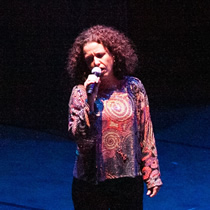A near-capacity crowd filled Memorial Hall on the UNC campus in Chapel Hill on an unseasonably cold evening to hear one of the most prominent Indian musicians perform with his two sons and a tabla percussionist. I have been wanting to hear Amjad Ali Khan Bangash (b.1945) for years, but this is the first time I’ve made it to a concert. At least half the crowd was from South Asia, maybe more.
The sarod is a popular instrument in South Asia but not often seen elsewhere. The history of its development is somewhat ambiguous; Indians are frequently more relaxed about the historical record than in other, more anal-retentive, cultures. Whatever the origins, the design of the instruments used here stems mostly from the early 19th century and was heavily influenced by the evening’s maestro’s sixth-generation-back ancestor, Ghulam Ali Khan Bangash. The family has continued alterations and variations on the design. The resonant body is covered with goat skin, giving a timbre much like a banjo. Steel strings are plucked with a coconut plectrum. The lack of frets gives greater expressive possibilities, and adds to the technical challenge of performance. Unlike western string instruments, the left hand stops the strings using the fingernails of two fingers. Given the way the sarod is constructed, stopping strings with only the soft tip of the finger as with a violin would mute the tone and completely change the sound, and not for the better. The fingerboard is steel; some prefer a polished stainless steel, while Amjad Ali Khan uses nickel-plated cast steel. Either way, the lights reflect off the fingerboard, and flash around the audience – which can be hard to put up with when shining directly into dark-adapted eyes.
Khan’s instrument has a ton of strings, which leads to much periodic fiddling with the many tuning knobs to keep them in line. There are four strings for melody, four as drones, and eleven sympathetic strings for resonance. To fill an auditorium the size of Memorial Hall, the performers used close mics and large speakers.
The concert began with Khan’s two sons, Amaan Ali Bangash and Ayaan Ali Bangash, with a superb tabla player who was not credited in the program.* (His name was announced from the stage, but in a heavy accent, and I didn’t catch it. My apologies!) The first sounds to be heard were of an electronic drone, taking the place of a tanpura. One less paycheck. That was somewhat disappointing. The two sons are certainly fine players, but this critic, however Indophillic, doesn’t have the depth of understanding to give a blow-by-blow. The audience knew when to clap, which betimes was quite mystifying to me. It reminded me of attending a play or opera in an indecipherable language, when the audience would suddenly laugh at what must have been a joke.
After forty-five minutes, the sons left and were replaced by the elder master. (The concert was without intermission, and as a result of its length, some needed to traipse through the dark and down crowded rows to attend to business.) He most certainly has total command of the sarod. After a bit, he took the nearest microphone, and started describing a tune in what can only be characterized as an old-guy croak. I thought, “oh no…”, but somehow, he transformed that into a brilliant riff that the audience loved. The guy can actually sing quite well. Then back to his solo sarod improvisations.
The sons came back for three-sarod music, plus the ever-present tablas. Set side by side, it was clear even to relatively unskilled ears that the elder musician was on a level all his own, despite the virtuosity of his offspring. There has already been a safe transmission of the musical heritage to the seventh generation.
As you might imagine, it was a challenge to keep interest going with such limited range of timbre. It would be impractical to attempt a concert of this length with, say, three banjos and a drum set; but the sarod is a more sophisticated instrument, and these musicians are experts. Still, it is a stretch for a westerner not accustomed to the sound, as well as the details of the ragas, to appreciate a long concert with such limited instrumentation. Music, despite what you may have heard, is by no means a universal language. In less experienced hands, the format would likely not work very well, at least with the kind of attention span we have these days.
This evening was a delight, and a testament to the depth and sophistication of the Hindustani classical music tradition. I encourage attendance next time that these three grace the stage here in North Carolina.











